Founded 1891
Registered Charity No: 510783
Annual Subscription
Ordinary member £15.00
Full time student £1.00
Officers and Council 2022
President Steve Gater
President Elect Vacant
General Secretary Sue Weston
Membership Secretary Fleur Miles
Treasurer Martin Chisholm
Summer Programme Derek Risbey
Winter Programme John Turner
Editor Lynne Heslop
Section Organisers
Archaeology Steve Keeney
Botany David Selby
Geology Elizabeth Elliott
Lepidoptera Brian Wood
Mammals Ian Bond
Marine Biology Carole Sobkowiak
Mycology Jill Cunningham
Ornithology John Turner
Projects Carole Sobkowiak
Other Members of Council
Mary Atkinson, Barry Chapman, Falgunee Sarker
Other Organisations
AES
British Pteridological Society
BSBI
Durham Wildlife Trust
Ramblers
YNU
Yorkshire Wildlife Trust
CONTENTS
Council Reports
President Steve Gater
General Secretary Sue Weston
Membership Secretary Fleur Miles
Treasurer Martin Chisholm
Summer Programme Derek Risbey
Winter Programme John Turner
Editor Lynne Heslop
Section Organiser Reports
Archaeology Steve Keeney
Botany David Selby
Geology Elizabeth Elliott
Lepidoptera Brian Wood
Marine Biology Carole Sobkowiak
Mammals Ian Bond
Mycology Jill Cunningham
Ornithology John Turner
Projects Carole Sobkowiak
Special Reports
President’s Report – Steve Gater
I started my talk last year by saying that taking over the Presidency of our club was a great privilege and honour. Twelve months on I am even more indebted to you for extending this opportunity to me and I hope that I have fulfilled at least some of my duties.
As a member of the club, you are key to it’s on-going success in the 14th decade of its existence. Simply by being a member is enough to show your interest and support. And so many of you do much more by attending meetings and events, organising and running trips, serving on Council and as Officers. There is an amazing teamwork and collective enthusiasm that ensure that our club runs effectively and makes an impact. And long may that continue. So I thank you all, for everything that you do and for your support.
Over the year we have been able to slowly return to a more pre-Covid normality, with face-to-face meetings both in and out of doors much welcomed and appreciated. What a relief, what a joy! Not everything has gone well and we mourn the loss of Dr Elizabeth Elliott, such a keen, informed and dedicated club member and leader. Yet we will build on happy memories and continue to develop our collective interest in natural history, near and far.
Our field visits over the extended summer of 2022 were varied and interesting. Leaders put much thought, time and effort into planning, running and reporting on a visit, so I thank them for their vital input. I know that there has been some disappointment with attendance of some events, understandably so, although for me the quality of an event outweighs the quantity of participants. And I have certainly enjoyed every trip that I have been on. I thought I knew quite a bit about natural history, and with the input of folk on our trips I have learned and now know much more – thank you all! And a thank you to Derek for organising the programme and maintaining details on the club website. If you have any feedback on field visits it is always welcomed. A big thank you too to Sue for the behind-the-scenes secretarial work that glues everything together. And to section leaders for their support.
Equally, the programme of winter talks has offered a good spread of topics to appeal to different passions. The timely introduction of new equipment to support speaker delivery has been an invaluable investment and had some impact against those rumbling freezer motors! Thank you Martin for sourcing the best deals. While temporary reorganisation of our meeting room has created problems I am grateful for the members’ acceptance and patience. With luck we will be back to normal with the next winter programme. A thank you to John and to speakers, particularly those who stepped in at the last minute to fill sudden gaps. I’ve been highly impressed by all talks.
Council has met regularly to consider and decide upon club activity and I thank everyone for serving and actively contributing. We made some carefully considered changes, including the Annual Report becoming digital only, upping subscription fees, buying equipment. Choosing to engage with community matters, supporting events run in South Park, arranged by the North Pennines AONB, Darlington Borough Council, Brightwater Landscape Partnership and others are key ways in which our club has shared its expertise and has made an impact. The work led by Carole, Elizabeth and others has certainly made a big difference in the proposed development of the Parkland in Blackwell. No doubt there will be other opportunities in 2023 and I welcome your thoughts, your interest and your support in the year ahead.
General Secretary – Sue Weston
The year started with talks from Jill Cunningham and Fal Sarker at the Queen Elizabeth 6th Form College.
March saw the Yellow Star of Bethlehem walk and this year it was dedicated to the memory of Don Griss. The book ‘Zig Zag Ramblings of a Naturalist’ by Dr Richard Taylor Manson was presented to the Field Club by Mary Griss. The book belonged to Don Griss and the book’s author was a founder of the Field club. As an important artefact, it has been decided that the book, along with the whistle will be presented to the incoming president to read at their leisure.
The AGM was held as usual in April with Steve Gater taking on the role of President. Unfortunately, Steve had come down with Covid and his part in the AGM was postponed to a later date.
The Summer programme started with a trip to Staveley with John Turner.
Saturday 7th May was a wonderful opportunity for Field Club Members to visit High Force, have breakfast in the Hotel and look along the River Tees for any items of interest. This was a celebratory event for the 130 years of the club and was based on a similar event many years earlier! A delightful and important event enjoyed by members.
The last Winter Meeting at Queen Elizabeth 6th Form College was on Wednesday 4th May.
The year continued with some splendid outings as mentioned in the Summer Programme report.
In September the Club had a stand at the Freshers Fair at the Queen Elizabeth college where information was provided regarding the Club’s activities and students could view various natural objects via a microscope and PC.
October saw the start of the Winter Program arranged by John Turner.
Twenty two Club members met at The Mowden Pub for a Christmas lunch that was very nice and enjoyed by all.
The club also acquired a new laptop for use by the secretary and for Winter Meeting talks.
I would like to thank members for sending reports and information for the monthly newsletters during the past year.
The Club held four Council Meetings during the year where club business was discussed and cascaded to members. I would like to also thank Council Members for assisting with the running and minute taking in meetings during my absence.
Membership Secretary – Fleur Miles
After a year out as President of the Field Club from March 2021 to March 2022, I resumed my role as Membership Secretary at the March 2022 AGM. I would like to thank Brian Wood for fulfilling the role of Membership Secretary during my Presidency.
Membership, at the moment, stands at 66 in total: that is 61 Members, 4 Honorary Members and 1 Life Member. Membership, so far, has gone down by 3 Members. Sadly, Dr Elizabeth Elliott passed away on Monday 16 January 2023 and two people decided not to renew due to mobility reasons but kindly made a donation to the Club. At the time of writing (Jan 2023), we are awaiting 18 renewals.
I would like to thank Martin Chisholm, Sue Weston and Brian Wood for their assistance during this – my fourth year -as Membership Secretary.
Treasurer – Martin Chisholm
The accounts are prepared on the receipts and payments method and are for the financial year ending 31 December 2022. Overall, there was a loss of £172.28 compared to the nearly £400 loss in 2021.
Due to the increase in annual subscription rate from £10 to £15, income showed growth over 2021. In addition, due to catching up on HMRC submissions, tax rebate revenue was healthy. The return to face-to-face meetings restored some income from entrance donations.
Printing expenditure was reduced based on a reduced format annual report. This will disappear in 2023 due to the decision to move to a digital version only. The website cost in 2021 was for 2020. The cost shown this year covers 2021 and 2022. Insurance increased in line with market forces. Attempts may be made in 2023 to find a lower cost alternative. A major upgrade in the capability of the club to be independent and professional in its presentations is shown in the equipment line where we have purchased a new laptop computer, clicker, cables, Microsoft and antivirus software plus a new projection screen. The club ran no Sponsorship activities during the year thus no exceptional items.
The Operational Income for 2023 should be similar to 2022, with the forecast increase in annual subscription offset by the reduction in tax refund due. Expenditure to maintain the functionality of the club should reduce due to the removal of the annual report cost, reduction of website costs to single year, the potential to reduce the insurance costs as well as no current forecast for additional equipment. No Wildlife Explorer events or sponsorship activity is currently forecast, though under normal circumstances would be funded from reserves.
The Club’s reserves policy aims to ensure one year’s running costs are covered and remains at a conservative £5000. This amount is now held in the Business Premium account in order to gain a small amount of interest and to more easily identify the reserve. The balance remains healthy for use to support the aims and objectives of the Club. Council has approved Sponsorship projects and activities to encourage the involvement of children and families in natural history. Hopefully these can resume at some point during the year. The surplus of the Balance over Reserves easily covers any likely expenditure in 2023.
At the time of writing the Accounts are yet to be audited, though with the relatively straightforward activity on the Account, no issues are foreseen. Thanks go to Ian Hart for his continued contribution to the audit process.

Summer Programme – Derek Risbey
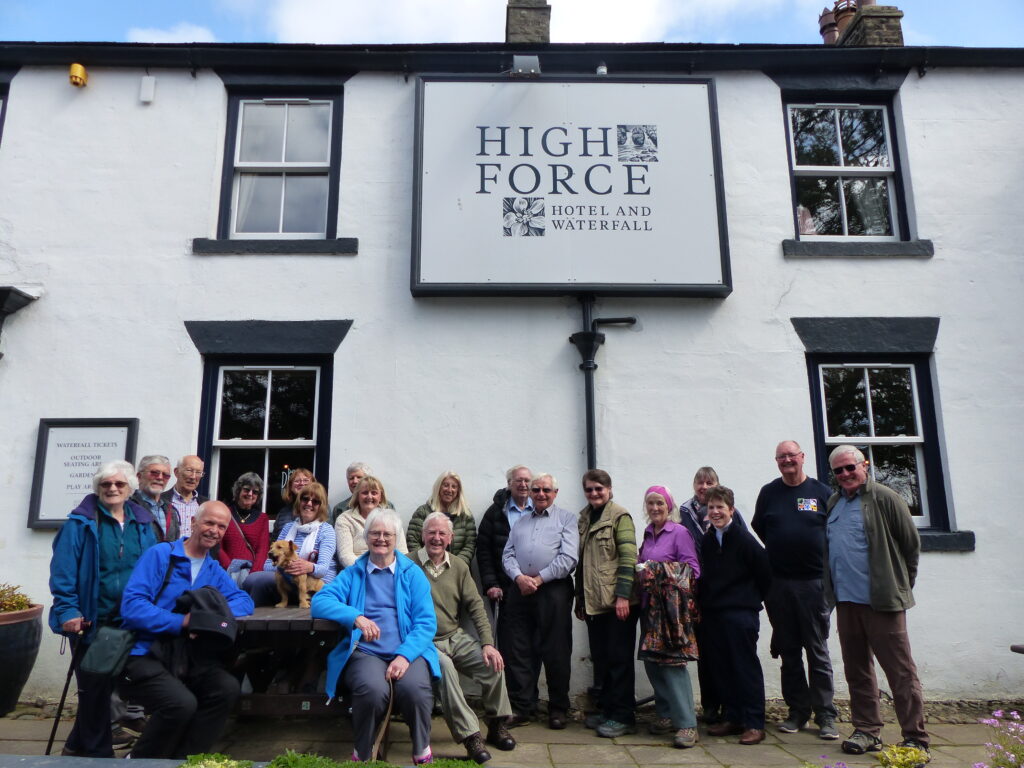
Can I start by saying a big thank you to all who contributed to the summer program 2022. It finally worked out very well with a slow start due to Covid but in the end 34 events were held.
By far the most successful event was our 130 years celebration, recreating an outing from 1897, having breakfast at High Force Hotel which was much enjoyed by all. Followed by a walk from Cow Green Reservoir car park, to the Dam and back, finding many rare plants, the Spring Gentian, Bird’s-eye Primrose, also Moonwort, and other Fauna and Flora. The Northern Echo made a double page spread about the event which was very good publicity for our club.
We started the year with the walk to see the Yellow Star of Bethlehem flower at Low Coniscliffe, it was a walk that Don Griss would do each year.
We had many good outings throughout the year and we joined with the YNU (Yorkshire Naturalists Union) for three different events.
One walk to Brignall Church was canceled due to the rain. We will try again this year. We had two outings to the South Lake District, both really great. One to Leighton Moss and Arnside Knott, the other to Whitbarrow Scar. The weather was good for both events and they were well attended.
Outings to the coast, country and locally, provided good recordings and many treasured memories. I would like to finish by saying thank you to all the members who attended the events.
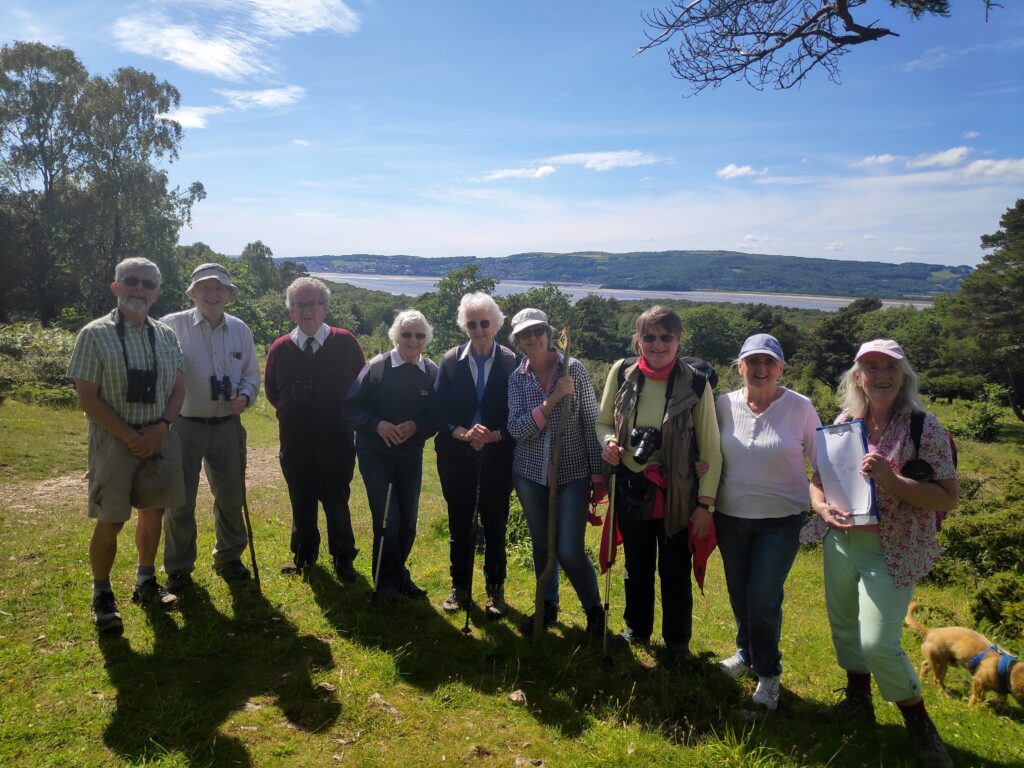
April 2022
23rd Staverley – John Turner
30th Bolton on Swale – John Turner
May
3rd Snipe Pond – Elizabeth Elliott
4th Indoor Meeting – Steve Gater
7th 130 year Celebration – High Force and Cow Green
10th Gainford – Sue Weston
15th Piercebridge – Steve Keeney
17th Blackwell Parkland – Carole Sobkowiak
21st YNU Jervaulx Abbey – Derek Risbey
24th Drinkfield – Lynne Heslop
28th Seal Sands – Ian Bond
June
7th Brafferton – Sue Weston
12th Smardale – Sue Weston
14th Leighton Moss – J Turner, D Risbey
18th Muker – Carole Sobkowiak
21st Hell’s Kettles – Falgunee Sarker
26th Oakenshaw Reserve – Jill Cunningham
28th Brignall Banks (cancelled) – Derek Risbey
July
3rd Hardraw Falls – Derek Risbey
5th Gainford South – Lynne Heslop
9th YNU Strensall – Elizabeth Elliott
12th Baydale Beck – Vince Robertson
16th Upper Teesdale – Tom Fowke
19th Hurworth Burn Reservoir – Mary Atkinson
23rd Slitt Wood – Steve Gater
26th Whitbarrow Scar – David Selby
30th Saltburn – Carole and Joe Scott
September
6th Indoor Meeting
10th
13th Bat Watch South Park – Ian Bond
17th Preston Park – Jill Cunningham
20th High Grange – Vince Robertson
24th Teesmouth – John Turner
27th Low Barns – John Turner
October
1st Fungus Foray Welbury Grange – Jill Cunningham
Winter Programme – John Turner
January 2022
12th Jill Cunningham – Ragwort and its associated insects
Fal Saker – Introducing blind/poor sighted people to botany
February
9th Ken Smith – Teesmouth birds
23rd Derek Risbey – 1. History of DTNFC, 2. BOTANY
March
9th Prof. Bob Baxter – Reindeer in Northern Finland and the effect
on them of human activities.
23rd AGM followed by the incoming President’s presentation
October
12th Jill Cunningham – Local fungi
19th Keith Robson – How I managed in “the 1000 in 1KM square
challenge
November
2nd David Selby – To Shangri La and beyond
9th Ben Lamb -The management of river catchments
16th Short talks
- Ian Bond – The harvest mice survey
- Jill Cunningham – Galls in the locality
23rd Vickey Ward – The wider Seascape Project
30th Heather Kelly – The Raisby LNR and other limestone
environments
December
7th Christmas lunch organised by Sue Weston
14th Margaret Enstone – Sustainability and climate change
management in Darlington
Editor – Lynne Heslop
Thank you to all the Council Members for submitting their reports with accompanying photographs. This is the first year that we are going totally digital and hopefully members will be able to access the Annual Report easily on the club website and in time for the AGM. Due to unforeseen circumstances some of the reports are still pending but will be uploaded as soon as possible.
Section Organisers’ Reports
Archeology – Steve Keeney
I would like to thank Field Club Council Members and Programme Organisers for the hard work they do to ensure the Club thrives so we can enjoy outings and talks throughout the year. I would especially like to thank walk leaders and encourage more members to lead walks. So we can all enjoy natural history in our local area in landscapes full of historical interest.
What a fantastic area we live in; Durham with incredible examples of mediaeval architecture, a UNESCO World Heritage site and we are so close to many fine archaeological sites such as Binchester, Piercebridge, Auckland Castle etc.
Founded in 1931 Durham University has now the largest Archaeology Department in the Country. With nationally leading research laboratories in DNA, Conservation isotope analysis, environmental archaeology, luminescence dating, paleopathology and bone chemistry. As a result Archaeology is experiencing an exciting time of scientific and forensic improvements allowing us to better understand what happened in the past.
On the 15th May 2022 I led an outing to Piercebridge to look at the remains of the Roman Bridge and Roman Fort excavations. In addition to information on the Roman remains; the outing was helped by the Tees Archaeology Booklet on the English Civil War with maps and information on the battle of Piercebridge on the 1st December 1642. The Parliamentarians were defeated but not before the Royalist, Colonel Thomas Howard was killed in action. He was buried at High Coniscliffe church on the 2nd December 1642.
I look forward to a new year with optimism and hope for a good year for the Darlington and Teesdale Naturalists’ Field Club. I really enjoyed the Club’s breakfast at the High Force Hotel on the 7th May 2022 to celebrate the longevity of the Field Club club and end with a wish for us all to enjoy many more years of discovery and enjoyment as part of the Field Club family.
Botany – David Selby
At last! Freedom, and we used it well with 33 events planned and most completed in an excellent summer.
The Botany Section was well represented on most outings and reports have been produced already so this report summarises the highlights together with an excellent contribution from Fal on significant trees in Darlington.
A number of members took part in the New Year Plant Hunt, organised by the BSBI. The mild winter meant it was quite successful and members found between 12 and 20 species on their 3-hour hunt which were then recorded on the BSBI national database.
On the various outings, botanical highlights (less common plants) included:
- On the Brinkburn Pond walk last spring, Water Crowfoot, Ranunculus aquatilis, was blooming near the Black Path, alongside the disused Rolling mills
- Greater Knapweed, Centaurea scabiosa and Leopard’s Bane, Doronicum pardalianches, was found along the old railway line at Hurworth Burn. Wild Angelica, Angelica sylvestris was also growing close to the spring in the meadow. Mary Atkinson adds, “if not rare it was delightful to see in bloom locally.”
- At Oakenshaw Climbing Corydalis, Ceratocapnos claviculata, was found growing under path edge conifers. This is not such a common plant in Durham as it likes acidic ground
- A Field Pansy, Viola arvensis, was found near a farm gate on the Bolton on Swale meet in April. It is probably a declining species due to modern farming practices.
- Stonewort, Chara vulgaris, was still abundant in ponds at Staveley in April and it was also found recently in the pond at South Park
- On a private walk, Jill Cunningham also found Alternate-leaved Golden-saxifrage, Chrysosplenium alternifollium, (a rarer find than Opposite-leaved), and Toothwort, Lathraea squamaria was in abundance at Thorsgill, Barnard Castle.
- Western Hemlock, Tsuga heterophylla, was identified on the Gainford South walk in July. It was introduced to UK in 1851.
- On our visit to Whitbarrow Scar, a limestone plateau south of Kendal, was full of calcarious loving plants in July. The more unusual finds included the Flea-sedge, Carex pulicaris, identified by Steve Gater and a Carline Thistle, Carlina vulgaris. An added bonus was a vast panorama down Morecambe Bay as far as Blackpool Tower on a beautiful day.

Falgunee Sarker has contributed the following report:
Special Trees of Darlington
- An Incense Cedar tree, Calocedrus decurrens can be found in the West Cemetery in Darlington. It is a narrow-columnar shaped tree with rounded top. Male and female flowers are on the same tree and the cone is goblet/tulip shaped. The crushed foliage smells of boot polish!
- The Tulip-tree, Liriodendron tulipifera is also present in the West Cemetery. It is a very old and large tree. The leaf is four-lobed with pale yellow flowers that appear in mid- June, usually at the top of the tree.
- The Dawn Redwood tree, Metasequoia glyptostroboides can be seen in front of the old Arts Centre, close to QE College, and there are four more trees in the Blackwell Grange Park. This tree was the most exciting discovery in the year 1941. It was known to the botanists from the fossil evidence going back 100 million years. This is the only living species of the genus Metasequoia, an evolutionary link between two conifer families, Taxodium and Redwood. The tree has bark like Sequoiadendron but it’s foliage like Taxodium, loses its leaves in winter, like the Bald Cyprus or Swamp Cyprus, Taxodium distichum. This tree has gone through evolutionary changes for the past 65 million years and is a critically endangered tree.
Geology – Elizabeth Elliot
Early this summer the club held a breakfast at High Force to commemorate 130 years since the club was formed. Afterwards members travelled further up the dale to near Cow Green Reservoir and saw the Spring Gentians, Gentiana verna in bloom. This plant particularly likes the sugar limestone which is found there. Another special plant of the area is Birds-eye Primrose, Primula farinosa, which also likes the limestone.
Another interesting trip was to Slitt Wood at Westgate in Weardale. Here we parked on the main road through the dale before going northwards through a wooded area and on to rather rough open ground. This ground had been extensively mined for various minerals in the past. We continued on up the hillside and from the road could see wide areas which had been mined. This trip was interesting but hard work due to the uneven terrain.
In December we had a talk from Vicky Ward who works for the lottery funded Wider Landscapes project. This project is concerned with the restoration of the Durham Coast and its coastal path. This area was heavily mined for coal with seams going out under the sea. The waste was tipped off the cliffs into the sea affecting the wildlife in the sea and on the beaches.
We hope that we may be able to visit this stretch of coast during the coming summer perhaps with a member of the Wider Landscapes project and see the improvements which have been made
Lepidoptera – Brian Wood
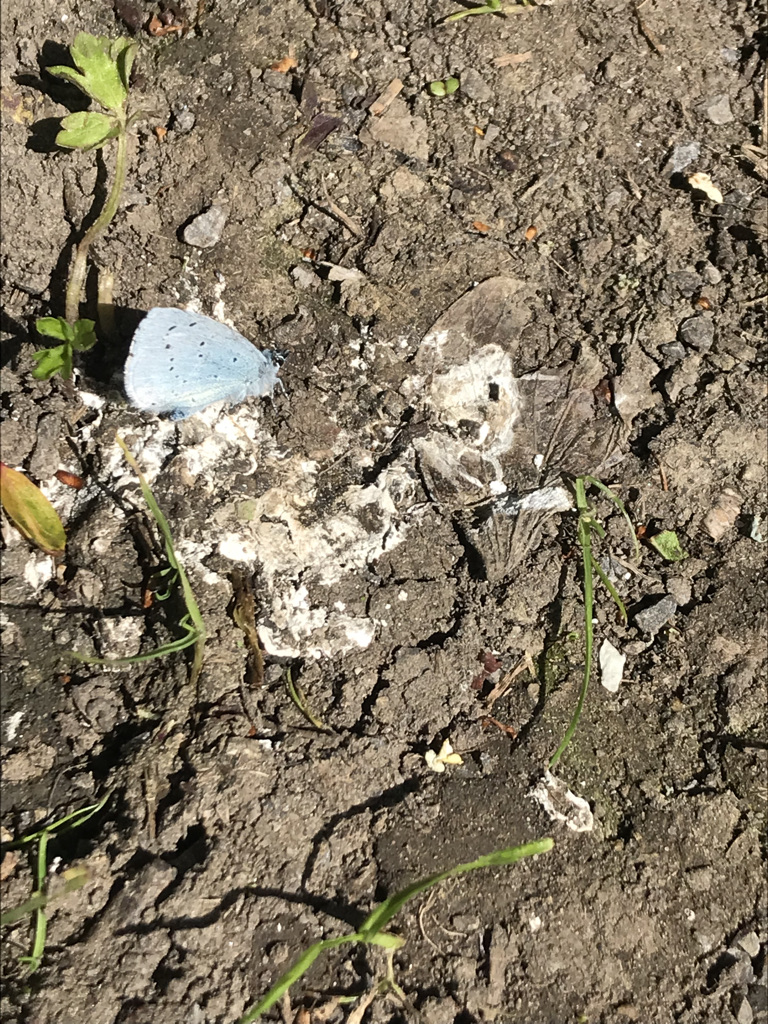
Holly Blue
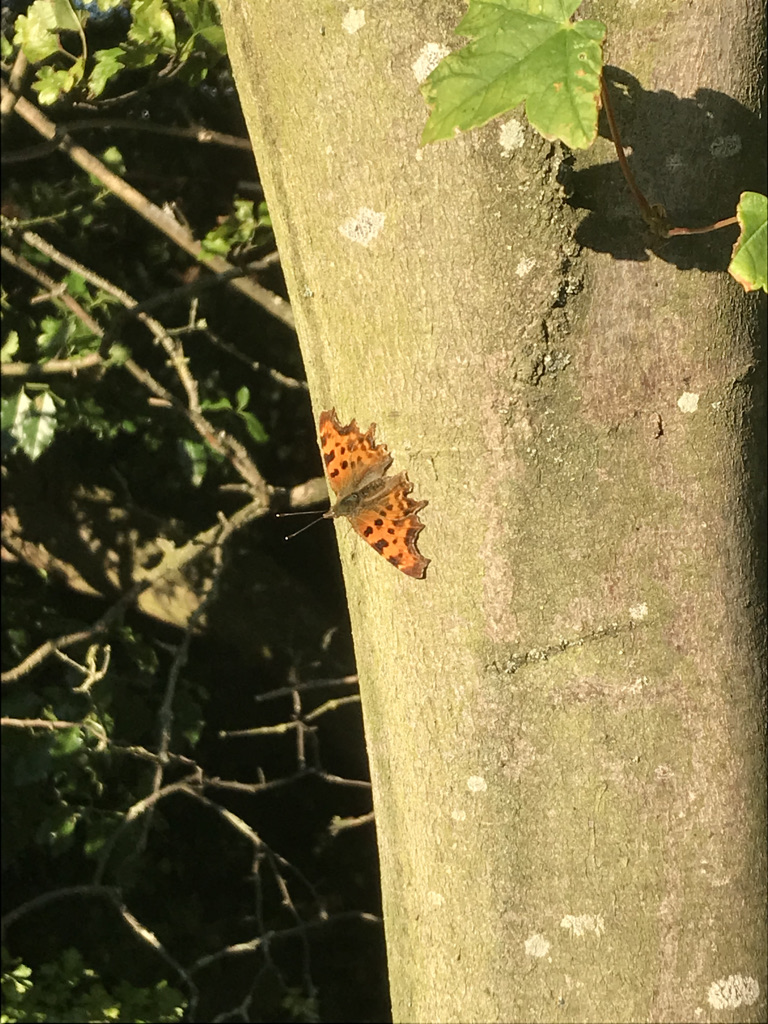
Comma
It was a very topsy turvy year for butterflies in 2022 the very cold and wet spring decimated the early breeders although the remarkably long hot summer went some way to benefit those species with second broods. Overall the trend for butterflies across the UK is still declining with lower numbers again recorded in the Big Butterfly Count 2022. Locally I had good numbers of Common and Holly Blues with these species making a comeback after a poor year previously. I am standing down from the Lepidoptery Section at the next AGM but the very capable Fleur Miles is taking over so please send your sightings and reports to her, please remember to include info such as date, species, weather, activity (feeding flying drinking mating) and numbers seen. Thanks to those members who have sent me their sightings over the last few years.
Mammals and Herptiles – Ian Bond
It was a fairly quiet year for mammal reports, at least in the Darlington and Teesdale area, though a little further afield there were some very interesting developments. The only specifically mammal-themed event that the field club ran this year was the bat walk in South Park, which was attended by nine members and two guests. We encountered three species of bat, both Soprano and Common Pipistrelles, plus Daubenton’s bat over the lake. We had good views of all three species but particularly the Daubenton’s. I have done bat walks at South Park for well over a decade and I would say that this year was clearly the most Daubenton’s that I have encountered on the lake. There was a potential concern that the new fountains in the lake would deter Daubenton’s bats, due to interference with the bat’s echolocation from the ripples. To mitigate for this Fal Sarker had got agreement that the fountains would be switched off overnight. This wasn’t the case on any of the three occasions when I visited this year but in practice that didn’t seem to be an issue as the bats did not appear to be avoiding any areas. Instead I wonder if the extra aeration has increased the populations of aquatic insects and that is attracting more bats. Conversely my annual count of Daubenton’s bats on the Skerne between Victoria Embankment and Parkside had the lowest level of bat activity that I have recorded in any year. It may be that some of the bats that used to forage over the Skerne have switched their foraging to the lake. Whatever the reasons, there are certainly plenty of Daubenton’s bats in South Park and on occasion we had them flying within inches of us.
The other notable mammal find on the field club excursions this year was a Harvest Mouse nest in a clump of Reed Canary Grass at Staveley. Harvest Mice are very rarely encountered this far north and it was the first time that any of the members, other than me, had seen their nest. Later in the year Janet and I found a couple of their nests on a walk near Hardwick Hall, which was quite significant as it was almost a new hectad record. Much more significant still was the finding of a Harvest Mouse nest at Low Barnes by Durham Wildlife Trust volunteers while cutting reed. To my knowledge this was only the third record of Harvest Mouse for Weardale ever, with the first being some 150 years ago and the second a probable but not proven record at the other end of the dale at Rookhope.
The other small mammal making the news this year was the Greater White-toothed Shrew, discovered by Melissa Young’s cat in Easington Lane and identified by me (we even got an appearance on Radio 4’s Today programme out of it, we being me and Melissa, not me and her cat). The shrew occurs in Western Europe but is not native to Britain. There are concerns that it might become invasive, as it has in Ireland, though so far there is no sign of that. To track its progress, the Mammal Society has launched a “searching for shrews” project, in which they are asking people to send in photos of shrews or other small mammals that their cat has caught. The project should be up and running by the time you read this, so for details just go on their website and search for “searching for shrews” however, I’m sure I don’t need to remind you that if you do get any records of small mammals, your friendly neighbourhood Field Club mammal section leader would like first dibs on them.
It has been a record year for the seal colony on Teesside, in almost every respect. There were record numbers of Harbour Seal pups; record numbers of Harbour Seals; record numbers of Grey Seals and for the first time ever we recorded over 200 seals hauled out at the same time. In fact there were five days this year when more than 200 seals were hauled out. Those records were made during the annual monitoring programme run by INCA over the summer but to put the icing on the cake, in late December, Dave Britton photographed a baby Grey Seal with its mother on the Seal Sands peninsula. This is the first time that a Grey Seal has been born on Teesside. Whether it proves to be the first of many we will have to wait until next year to see.
There has been almost nothing to report on reptiles and amphibians this year. Perhaps the only thing of significance was that I caught two female Alpine Newts in the fish pond in my garden. The fish pond has now gone (in favour of a granddaughter) so that might be the end of them.
Finally, I had my first sighting of a Water Vole in the North East since 2005. It was an adult vole which crept out of its hole, right in front of the Wildlife Watchpoint at Saltholme, so close that I could see the stains on its incisor teeth as it munched the grass. Technically it was on 1st January 2023, rather than a 2022 report, but I was so excited that I couldn’t wait until next year’s report.
Marine Biology – Carole Sobkowiak
Pending
Mycology – Jill Cunningham
Many people think that fungi are just to be found in the Autumn but micro-fungi in particular can be found throughout the year often on living and dead leaves and branches. In January 2022 I recorded Entyloma chrysosplenii leaf spot and Puccinia chrysosplenii rust on Alternate-leaved Golden Saxifrage at Thorsgill near Barnard Castle, both being rare finds. I found the little black lumps of Pseudophacidium ledi fungus on old Heather stems whilst on a Lichen meet in March which were verified by Chris Yeates, YNU, as being a 1st record for Yorkshire. The bright red bulges of the uncommon, but often over-looked, Taphrina deformans infection were seen on Almond leaves in an Abbey Road garden in early May. Puccinia recondita rust on Common Meadow-rue was another rare find along with Puccinia vincae on Vinca major which surprisingly came back as a 1st record for VC65 at the YNU meet at Jervaulx later in May. Cercospora violae, a leaf spot on Dog Violet was another 1st Yorkshire record from the Strensall meet in July.
Brinkburn Ponds in December gave me Eutypella scoparia with its multiple tiny black prongs sticking out of an old fallen branch. This fungus also had a minute micro fungus growing on it – apparently mycologists know about it but it doesn’t have an ID yet as they don’t know enough about it. There appears to be tiny cellular tufts and also white micro-cups – but are they different states, (anamorph and teleomorph), of the same species or are they different species? There is still a lot to learn in Mycology – it’s just surprising to find an ‘unknown’ in such a local place!
Some of the more unusual larger fungi found on the DTNFC meets over the year have included the rough lumpy Chaga fungus, Inonotus obliquus, on Birch at Strensall, Silky Rosegills,Volvariella bombycina, seen growing atop of an old trunk during a September meet at Preston Park and later in the month Salty Mushrooms, Agaricus bernardii, were discovered growing on the edge of a Faverdale round-about during the High Grange meet. This species is usually coastal but is now also occasionally found inland on salted road verges. In October I was joined by interested locals at the DTNFC Fungus Foray at Welbury Farm. The hot, dry weather meant that little was seen on my 2 recces, but a week later after rain it turned up trumps with over 80 species seen in the 2 small woodlands which included the aromatic Aniseed Cockleshells, a big red tongue of Beefsteak Fungus and many Giant Puffballs. Finally, in the last week of December I spotted the wrinkled ‘splats’ of Tripe Fungus, Auricularia mesenterica, growing through dead Holly branches on an amble around West Cemetery.
A big thank-you to DTNFC members who have continued to email, Facebook and photo fungi seen on their walks: – fissured Common Morels at Weardale and Seal Sands; ‘edible but tasteless’ Trooping Funnels at Trinity Church; round plates of Dryad’s Saddles and Chicken of the Woods are just a few examples. Julie Kensole spotted delicate Pink Waxcaps, Hygrocybe calyptriformis, near Reeth – these are an infrequent find and also known as Pink Ballerinas as their caps uplift like a tutu showing the pure white ‘ruffles’ of the gills.
Despite the dry and unpredictable weather this year many fungi were in abundance after showers. Does this show their resilience or does the underground mycelium feel it has to push up sexual fruiting bodies as it is ‘unhappy’ in the dry and needs to spread its spores to hopeful better ground? Only future years will tell.
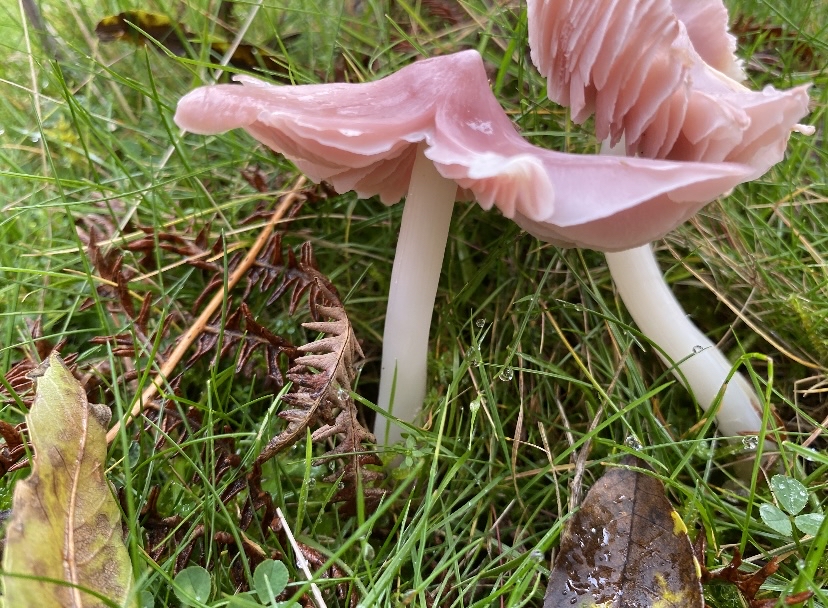
Pink Waxcaps, Hygrocybe calyptriformis, Reeth, Julie Kensole, Facebook

Silky Rosegill, Volvariella
bombycina, Preston Park
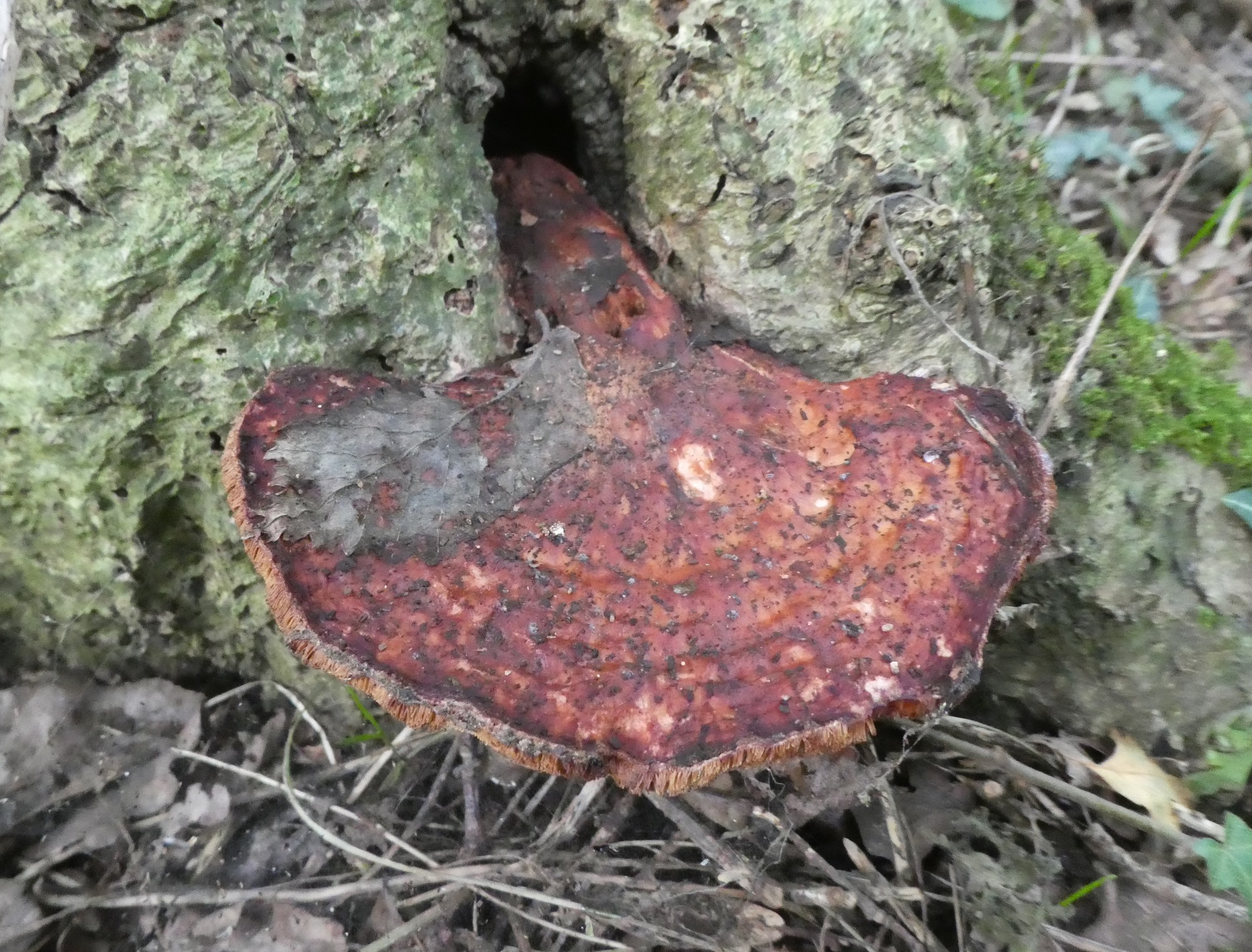
Beefsteak fungus, Fistulina hepatica, Wellbury Grange
Ornithology – John Turner
Pending
Projects – Carole Sobkowiak
Pending
Special Reports
Joint Field trips with NYU
Field Club members attended two Field trips with the YNU in 2022
Jervaulx Abbey May 21st:
Four members joined a group of naturalists at Jervaulx Abbey which stands on a beautiful site by the River Ure not far from Leyburn. The Abbey suffered from the dissolution of the monasteries. Today the site is privately owned and one can wander round. We went round the ruins and some also looked at the river bank.
We met some kind local naturalists who knew Wensleydale well and were able help with identifying the plants we saw in bloom around the ruins
Unfortunately there was a cool wind so we decided to leave before members met to discuss their findings but we had a fascinating day.
Strensall Common July 9th:
Five members attended this trip. Strensall is a village about 6 miles north of York. The area would have been in the past a part of the Forest of Galtrees, covered with trees and wild animals. Today there are fewer trees with some damp patches containing interesting vegetation and small creatures. The weather prior to our visit had been hot so some pools had dried up.
The army uses the ground as a practice area and so care has to be taken where you wander.
Arrangements had been made for us to meet for tea and have our discussion in the village hall. Experts in various fields attend these meetings and are willing to explain the features of the species. The meetings with the YNU are a wonderful opportunity to share knowledge and learn from others.
I would like to thank those who organise these trips and make us all so welcome.
New find – Falgunee Sarker
Discovery of a new charophyte (Stonewort) in Darlington.
In October 2022, a stonewort was found by Dean Heward, who works in the South Park, Darlington. But what is a stonewort? It is complex structured green algae that grow submerged under water. The condition for chara to grow is specific. Usually the pH is high and calcium carbonate encrusts the stonewort. So when one finds the plant, the crusts have to be removed to identify the beautiful chara. The Field Club was requested to investigate and I went to get a piece of the plant. The plant was confirmed to be Chara vulgaris and the final icing on the cake was completed by Chara expert Ken Adams, who identified the sample as Chara vulgaris form papillata.
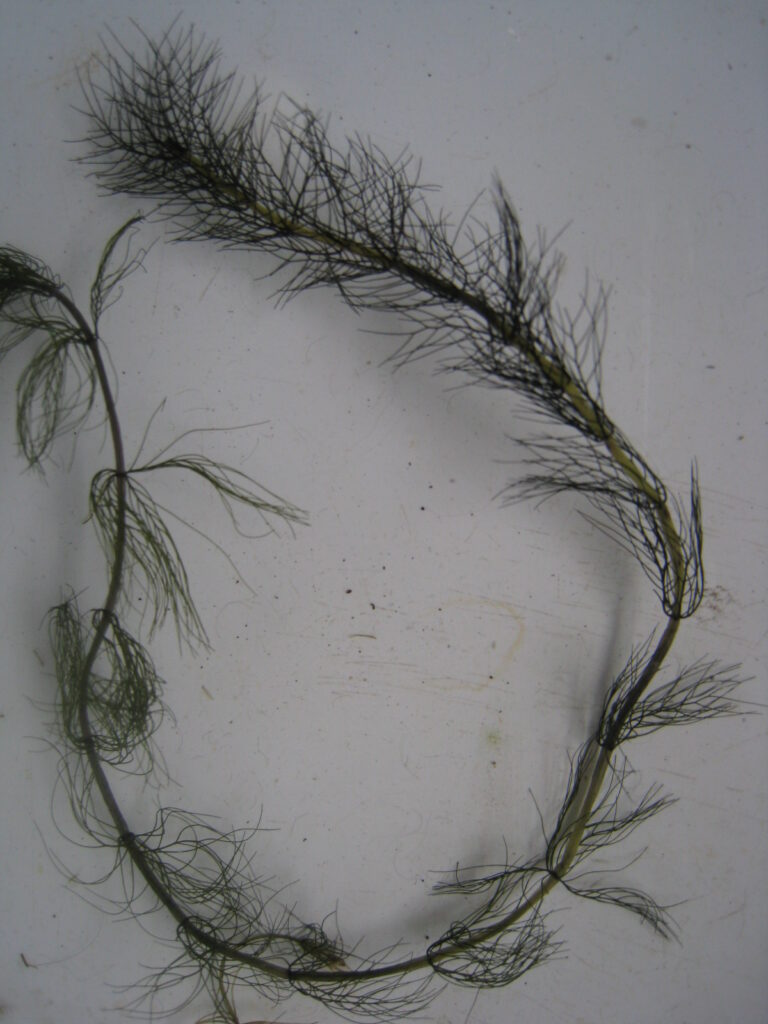
Don’s walk – Yellow Star-of-Bethlehem Gagea lutea
20th of March 2022 was the vernal equinox day in Northern Hemisphere, which marks the beginning of the spring season. The day was sunny with 13 degrees Celsius temperature. At 2pm twelve members from the club joined in this memorial walk to count the Yellow Star-of-Bethlehem at Low Coniscliffe village.
The ground is sandy and it gets inundated as the River Tees water level rises every year. Members were shown how to count each plant. We were counting only the flowering plant with a single basal leaf and one flowering stem per plant. This plant has 2-3 leaf-like bracts, but the basal leaf has unique acuminate hooded tip and three veins present. There were many plants without flowers. Here each club member made a valuable contribution and the total count was 605 flowering plants.
On 21st March 2021 the counts were 496 at this site. Our club member late Don Griss has been monitoring this for many years and it is very important that club continues this practice. This would provide much interesting information particularly in this global warming situation.
We have seen Cherry Plum Prunus cerasifera, one of the first trees to come into flower in spring. This has identical blooms to Blackthorn but flowers in April.
Blackthorn has clustered buds, smaller flowers but here buds were single and flowers bigger.
We recorded Sweet Violet Viola odorata with rich violet flowers and shiny leaves and Viola odorata var.dumetorum with white flowers. Both plants were in small patches with fragrant flowers. Ambient temperature plays a role in these sweet scented flowers. Wood Anemone Anemone nemorosa also carpeted the ground under the canopy of tall trees. Thanks to Lynne Heslop and Jill Cunningham for recording the flora. There were 605 plants recorded. We started our walk with the drumming of a Greater Spotted Woodpecker and at the end there was one Tree Creeper feeding on insects on a Beech tree. Thanks to John Turner for recording the birds. Jill pointed out rows of reddish brown fungus called Mensularia radiate growing in an Alder tree from the lower part of the tree right up to the top of tree. This was probably a dying tree. This fungus will eventually kill the tree and put all the nutrients back into the soil. There was one Tree Bumble bee Bombus hypnorum with ginger brown thorax and black abdomen with white tail. The queen bees are emerging now from winter hibernation.
I would like to think that the club will continue this valuable monitoring in future. Also my sincere thanks to all the members for counting the plants. The finishing touch was enjoying lovely refreshment at local Baydale Beck pub.
New Year Plant Hunt 2022/2023 – Falgunee Sarker
The aim of the New Year Plant Hunt is to build up a clear picture of which plants are flowering and where across Britain and Ireland.
We can see how our wild and naturalised plants are responding to changes in long term weather patterns.
Also any role played by altitude and proximity to the coast.
Urban site provides micro climates which can support more species in bloom than rural site.
How alien plants compared to native plants.
This is not about who has the longest list.
From 31st December 2022 to 3rd of January 2023 inclusive, Field club members were hunting wild flowers in all directions. This was an interesting NYPH. This year White Dead-nettle Lamium album was replaced by Petty Spurge Euphorbia peplus. The number of Daisy, Groundsel and Pineapple weed records were reduced. Less number of plants were recorded by each recorder.
Thank you to all the recorders.
